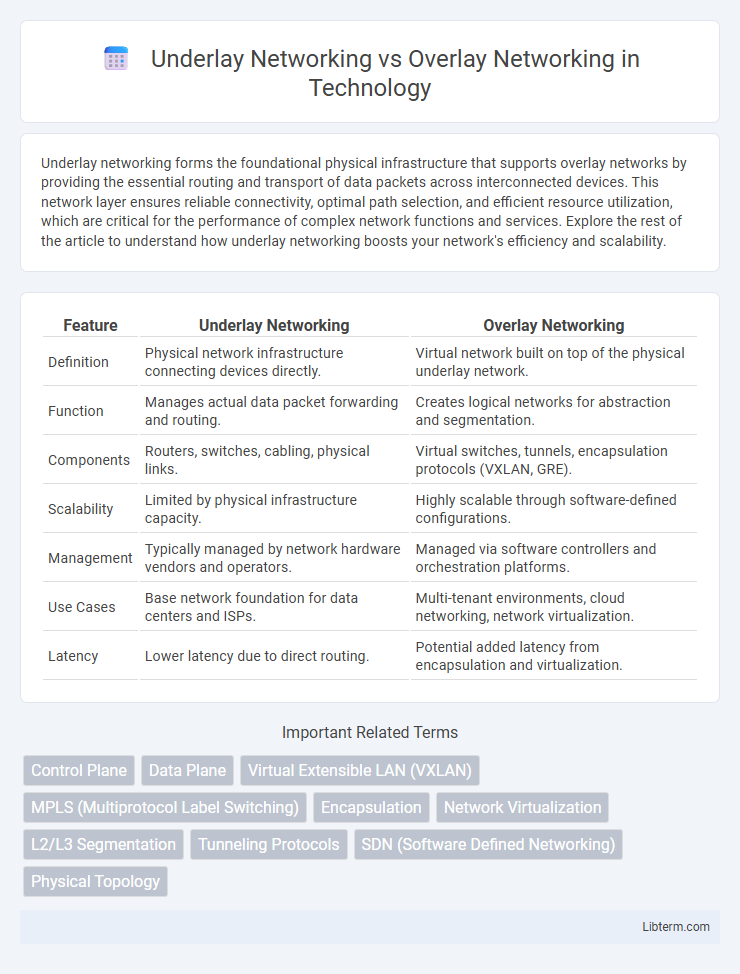Underlay networking forms the foundational physical infrastructure that supports overlay networks by providing the essential routing and transport of data packets across interconnected devices. This network layer ensures reliable connectivity, optimal path selection, and efficient resource utilization, which are critical for the performance of complex network functions and services. Explore the rest of the article to understand how underlay networking boosts your network's efficiency and scalability.
Table of Comparison
| Feature | Underlay Networking | Overlay Networking |
|---|---|---|
| Definition | Physical network infrastructure connecting devices directly. | Virtual network built on top of the physical underlay network. |
| Function | Manages actual data packet forwarding and routing. | Creates logical networks for abstraction and segmentation. |
| Components | Routers, switches, cabling, physical links. | Virtual switches, tunnels, encapsulation protocols (VXLAN, GRE). |
| Scalability | Limited by physical infrastructure capacity. | Highly scalable through software-defined configurations. |
| Management | Typically managed by network hardware vendors and operators. | Managed via software controllers and orchestration platforms. |
| Use Cases | Base network foundation for data centers and ISPs. | Multi-tenant environments, cloud networking, network virtualization. |
| Latency | Lower latency due to direct routing. | Potential added latency from encapsulation and virtualization. |
Introduction to Networking Architectures
Underlay networking refers to the physical infrastructure of routers, switches, and links that form the foundational layer for data transmission in a network. Overlay networking creates a virtualized network on top of the underlay, using tunneling protocols like VXLAN or GRE to enable flexible, scalable, and isolated communication. These architectures work together to separate physical connectivity from logical network design, enhancing virtualization and simplifying network management.
What is Underlay Networking?
Underlay networking refers to the physical infrastructure and foundational hardware components, such as routers, switches, and cabling, that facilitate the actual transmission of data across a network. It establishes the core data paths and routing protocols that ensure packets are delivered efficiently between devices. This foundational layer operates independently from overlay networks, which create virtualized network environments on top of it for enhanced flexibility and scalability.
What is Overlay Networking?
Overlay networking is a technique that creates a virtual network on top of an existing physical underlay network, enabling network segmentation, enhanced security, and flexible routing independent of the underlying infrastructure. It uses encapsulation protocols such as VXLAN, GRE, or IPsec to tunnel packets across the underlay network, supporting multi-tenant environments and software-defined networking (SDN). Overlay networks simplify complex network management and facilitate rapid deployment of virtual networks for cloud computing, data centers, and distributed applications.
Key Differences Between Underlay and Overlay Networking
Underlay networking refers to the physical infrastructure of routers, switches, and cables that enables data transmission across a network, forming the foundational layer. Overlay networking operates on top of the underlay, creating virtualized networks by encapsulating data packets, allowing for flexible network segmentation, improved scalability, and simplified management. Key differences include underlay handling the actual data path, while overlay abstracts and controls logical connectivity, often using protocols like VXLAN or GRE for tunneling.
Advantages of Underlay Networking
Underlay networking offers direct control over physical infrastructure, ensuring low latency and high throughput by minimizing packet encapsulation and overhead. It provides enhanced reliability and deterministic performance through dedicated hardware and optimized routing protocols like OSPF and IS-IS. This approach simplifies troubleshooting and improves security by reducing the complexity associated with virtual overlays and tunneling mechanisms.
Benefits of Overlay Networking
Overlay networking offers enhanced flexibility by enabling the creation of virtual networks independent of the underlying physical infrastructure, which simplifies network management and scalability. It improves security through integrated encryption and segmentation, isolating traffic within virtual tunnels for sensitive data transmission. Overlay networks also accelerate deployment of new services and support multi-cloud environments by abstracting complex hardware details and allowing seamless connectivity across diverse platforms.
Use Cases for Underlay Networking
Underlay networking is essential for delivering high-performance, low-latency connectivity in data centers, where physical infrastructure supports IP routing and switching at the hardware level. It is ideal for use cases requiring predictable network behavior, such as financial trading platforms, real-time video streaming, and large-scale enterprise applications relying on stable and direct packet forwarding. Underlay networks provide the foundational layer that ensures bandwidth efficiency, traffic engineering, and redundancy for critical workloads.
Use Cases for Overlay Networking
Overlay networking excels in cloud computing environments by enabling network virtualization that separates physical infrastructure from logical network design, facilitating multi-tenant isolation and dynamic scalability. It supports software-defined networking (SDN) use cases such as virtual private networks (VPNs), network segmentation, and automated service chaining, allowing for flexible and secure connectivity across geographically dispersed data centers. Enterprises leverage overlay networks to simplify deployment of microservices architectures and enhance traffic management without altering the underlying underlay infrastructure.
Challenges and Considerations in Deployment
Underlay networking faces challenges such as physical infrastructure limitations, complex hardware configurations, and scalability constraints that can affect performance and reliability. Overlay networking introduces considerations including increased latency, security concerns due to encapsulation, and the need for efficient management of virtual tunnels to maintain network stability. Both deployment types require careful planning regarding compatibility, resource allocation, and monitoring to optimize overall network functionality.
Choosing the Right Networking Approach
Choosing the right networking approach requires understanding that underlay networking provides the physical infrastructure including switches, routers, and cabling, crucial for low-latency and high-bandwidth requirements. Overlay networking, built on top of the underlay, offers flexibility through virtual networks like VXLAN or NVGRE, enabling rapid deployment, scalability, and isolation in multi-tenant environments. Organizations prioritizing stability and predictable performance often select underlay networks, while those needing agility and multi-cloud integration prefer overlay networking solutions.
Underlay Networking Infographic

 libterm.com
libterm.com